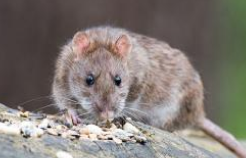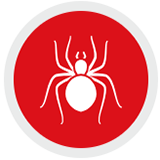Fleas are annoying blood-sucking pests who feed on the blood of mammals, including humans. They particularly prefer the warm fur of our unwitting pets. They can live almost anywhere, but once they arrive in your house, these tiny critters can be a real challenge to get rid of.
Here in Seattle, fleas are most active between March and December—however, pending a warm winter, they can also be active year-round. How can you know for sure your home is free of these harrowing pests? Read on as we discover the world of fleas and what makes them so dangerous.
What Do Fleas Look Like?
Fleas are small, wingless insects with flat, oval bodies that are about ⅛ to ¼ of an inch long. They come in a multitude of colors, including brown, black, and reddish-brown. These insects have 6 legs, of which the back two are the most powerful, allowing them to jump up to 8” vertically. Their flat bodies allow them to move along surfaces, while their hair gives them the ability to cling to their host.
Are Fleas Dangerous?
Yes, fleas can be dangerous, as their bites are irritating and pose serious health risks for your pets and family. Living in the shady areas of your lawn, such as under trees and shrubs, in tall grasses, and around decks and patios, these opportunistic pests can leap vertically up to seven inches and travel distances more than a foot, hopping on your pet and hitching a ride inside. Once they get inside the house, ridding your home of them can be extremely challenging.
A female flea can produce up to 2,000 eggs in one lifetime, laying them inside your pet’s fur or burying them deep within your carpet, upholstery, or bedding.
Why Are Fleas Dangerous For Humans?
Why Are Fleas Dangerous For Pests?
Signs Of Fleas In Your House
While fleas are tiny little parasites that are hard to see, there are a few obvious signs when they begin residing in your home. Usually, this starts with symptoms or unusual behavior from your pet. Here are the most common signs of a home flea infestation.
Excessive Scratching
Fleas especially like to attach themselves to your furry friends. The saliva from fleas causes an allergic reaction causing excessive scratching on or around the infested area. If you see your dog or cat incessantly scratching, you definitely want to look for fleas. Check your pet’s entire body, but especially focus on areas of the neck and head.
Ankle Bites
When fleas get into the home, they will likely begin using you and your family as hosts. If you start noticing small red itchy bites around your ankles, it may not be from mosquitoes or spiders but rather fleas. Flea bites typically have one tiny puncture hole at the bite site, whereas spider bites have two.
Pale Gums
If you suspect fleas are terrorizing your home or pet, check your dog or cat’s gums. Pale white gums are a symptom of anemia, which is common with flea infestations. If you find your four-legged friend has pale gums, get them to the vet immediately.
Loss of Fur
Another sure sign of a flea attack is hair loss. Excessive scratching can cause hair loss and bald spots.
Flea Dirt
When faced with a flea infestation in the home, you will typically discover small red-brown or black specks on or around your pet or on the bedding and furniture on which they lay. Called flea dirt, it’s actually feces from the fleas and looks similar to black pepper.
Flea Eggs
Not only do fleas lay eggs inside the fur of your pet, but they also love to lay their eggs inside your carpet, in floorboard cracks, on pet bedding, and beneath beds and furniture. Finding eggs in your house is a sure sign you have a flea infestation.
How To Test For Fleas
Moving into a new house or apartment and want to ensure you aren’t moving into an already made flea infestation? Or maybe you just want to ensure they are not in your current residence. Either way, there are a few ways you can check for these vile insects to keep your mind at ease.
First, pay attention to the carpets. Because fleas like to lay eggs in the carpeting, run your hands or comb through the fibers and look for visible droppings. Flea dirt looks similar to black pepper, so unless you’ve eaten in that area within the last few days, chances are it’s a sign of fleas.
Other ways to look for signs of a flea infestation include:
White Sock Test
Put on a pair of white socks and pull them up to your calves. Walk around on the carpet throughout your home, shuffling your feet to create warmth. Fleas are attracted to heat. Therefore, if they are present, you will likely find black or brown specs on your socks when finished.
Water And Lamp Test
For this particular test, you will need the following:
- Lamp
- Bowl
- Water
- Dish soap
Fill the bowl with warm water. Add a little soap detergent. Next, place the bowl on the floor and shine water over it. Attracted to the light, fleas will jump upwards and land in the water. Not only will the soap kill them, but you now have confirmation you have fleas.
Get A Professional Flea Inspection
If you are worried that you might be hosting a flea infestation, call a local pest control company. If you live in the Seattle area, contact Eastside Exterminators! First opening our doors in 1969, our experienced flea exterminators provide a comprehensive inspection to help you identify the pests plaguing your home.
FAQ About Fleas In Your House
Here are a few more insights that could help you figure out if you have fleas.

 (425) 318-7912
(425) 318-7912
 MY ACCOUNT
MY ACCOUNT
 425-318-7912
425-318-7912








